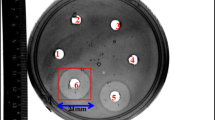Abstract
As part of a program to develop starter cultures aiding in the spoilage control and sanitation of African fermented foods, a cereal-based food (‘ogi’ and its solid form ‘agidi’ or ‘eko’) was prepared using a bacteriocin-producingLactobacillus strain as the starter culture. The survival of an enterotoxigenicEscherichia coli strain was investigated in the naturally fermented food and in food fermented with the starter bacteriocin-producingLactobacillus strain. An inhibition ofE. coli was observed within 2 h of incubation in ‘ogi’ fermented with the bacteriocin producing strain. After 6 h, the viable count ofE. coli in locally fermented ‘ogi’ was log 6.41 (2.54×106CFU/mL), whereas in ‘ogi’ fermented with the bacteriocin producer it was reduced to log 1.70 (0.5×102 CFU/mL). Comparison of the shelf life of ‘agidi’ prepared from the naturally fermented food with that fermented with the bacteriocin-producing starter culture showed that the latter had a better shelf life (kept for 11 d before spoilage occurred as compared with 7 d for the natural one). The results are discussed in terms of the potential of bacteriocin-producing cultures in the control and retardation of spoilage and food-forne infections in some African fermented foods.
Similar content being viewed by others
References
Breidt F., Crowley K.A., Fleming H.P.: Isolation and characterization of nisin resistantLeuconostoc mesenteroides for use in cabbage fermentations.Appl.Environ.Microbiol. 59, 3778–3783 (1993).
FDA: Nisin preparation: Affirmation of GRAS status as a direct human food ingredient.Food and Drug Admin., Fed. Reg. 53, 11247 (1988).
Frank T.F.: EnteropathogenicEscherichia coli.Food Technol. 42, 192–193 (1988).
Hansen J.N.: Nisin as a model food preservative.Crit.Rev.Food Sci.Nutr. 34, 69–93 (1994).
Hayes P.R.: Food spoilage, pp. 106–183 inFood Microbiology and Hygiene, 2nd ed. Elsevier Applied Science Publishers, London-New York 1992.
Harris L.J., Daeschel M.A., Stiles M.E., Klaenhammer T.R.: Antimicrobial activity of lactic acid bacteria againstListeria monocytogenes.J.Food Protect. 52, 384–387 (1989).
Hillman K., Spencer R.J., Murdoch T.A., Stewart C.S.: The effect of mixtures ofLactobacillus spp. on the survival of enterotoxigenicEscherichia coli inin-vitro continuous culture of porcine intestinal bacteria.Lett.Appl.Microbiol. 20, 130–133 (1995).
Hurst A.: Nisin, pp. 85–123 in D. Pelman, A.I. Laskin (Eds):Advances in Applied Microbiology. Academic Press, New York 1981.
Klaenhammer T.R.: Bacteriocins of lactic acid bacteria.Biochimie 70, 337–349 (1988).
Odunfa S.A.: African fermented foods, pp. 151–191 inMicrobiology of Fermented Foods, Vol. 2 (R.J. Wood, Ed.). Elsevier Applied Science Publishers, London-New York 1985.
Olasupo N.A., Olukoya D.K., Odunfa S.A.: Plasmid profiles of bacteriocin-producingLactobacillus isolates from African fermented foods.Folia Microbiol. 39, 181–186 (1994).
Olasupo N.A., Olukoya D.K., Odunfa S.A.: Studies on bacteriocinogenicLactobacillus isolates from selected Nigerian fermented foods.J.Basic Microbiol. 35, 319–324 (1995).
Olukoya D.K., Tichaczek P.S., Butsch A., Vogel R.F., Hammes W.P.: Characterization of the bacteriocins produced byLactobacillus pentosus DK7 isolated from ‘ogi’ andLactobacillus plantarum DK9 from ‘fufu’.Chem.Mikrobiol. Technol.Lebensm. 15, 65–68 (1993).
Spelhaug S.R., Harlander S.K.: Inhibition of food-borne bacterial pathogens by bacteriocins fromLactococcus lactis andPediococcus pentosaceous.J.Food Protect. 52, 856–862 (1989).
Steinkraus K.H.:Handbook of Indigenous Fermented Foods. Marcel Dekker, New York 1983.
Svanberg U., Stogren E., Lorri W., Svennerholm A.M., Kauser B.: Inhibited growth of common enteropathogenic bacteria in lactic-fermented cereal gruels.World J.Microbiol.Biotechnol. 8, 601–606 (1992).
Author information
Authors and Affiliations
Rights and permissions
About this article
Cite this article
Olasupo, N.A., Olukoya, D.K. & Odunfa, S.A. Assessment of a bacteriocin-producingLactobacillus strain in the control of spoilage of a cereal-based African fermented food. Folia Microbiol 42, 31–34 (1997). https://doi.org/10.1007/BF02898642
Received:
Issue Date:
DOI: https://doi.org/10.1007/BF02898642




